Dolby Atmos debuted in movie theaters in 2012, and made its way into living rooms and home theater systems two years later. By introducing something new to surround sound -- height information -- Dolby Atmos took surround sound to the next level. Instead of just hearing sounds from all around you, with Dolby Atmos, you hear sound from above as well, creating a super-realistic representation of sound as it exists in the real world.
Today you can find immersive Dolby Atmos surround sound encoded into thousands of movies and TV shows on Blu-ray Disc and in streaming services such as Netflix, Amazon Prime Video, Apple TV, MAX and Disney+. Dolby Atmos has even made it into thousands of music tracks on music streaming services such as TIDAL, Amazon Music and Apple Music. If you want the most widely available and most realistic surround sound available today, Dolby Atmos is where it's at.
But Dolby Atmos at home is expensive, right? It doesn't have to be. And no, I'm not talking about cheap one-piece soundbars with "virtual surround sound." It's possible to bring home near theater-quality discrete Dolby Atmos immersive surround sound without breaking the bank. The Klipsch Reference Cinema 5.1.4 Dolby Atmos Speaker System is one way to do that.
>> Check Out the Klipsch Reference Cinema Series 5.1.4 Speaker System on Amazon
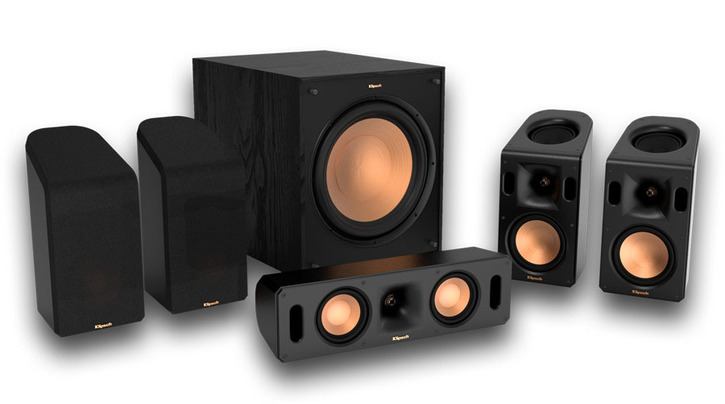
The Klipsch Reference Cinema 5.1.4 System with Dolby Atmos is a complete speaker system which includes nine discrete speaker channels, housed in five compact speaker cabinets, plus a powered subwoofer. How does it manage to squeeze so many speaker channels into so few boxes? Very carefully! The Klipsch system takes advantage of Dolby's reflective sound capability using Dolby elevation modules to bounce sound from the ceiling for the overhead channels. This creates real (not virtual) sound from above the listener, without the need to run wires on or inside your ceiling, or cut any holes in the walls or ceiling. As in many compact systems, lower bass duties are handled by a powerful but fairly compact powered subwoofer.
Though it says "Dolby Atmos" right in the product name, the system is compatible with any immersive sound format, including Dolby Atmos, IMAX:Enhanced, DTS:X, AURO 3D, MPEG-H and Sony 360 Reality Audio.
The system has been out since the fall of 2021 but was previously a Costco exclusive so it did not see widespread distribution or availability. Now it's available on Amazon and other online retailers. This expanded distribution has led to more competitive pricing. The system initially had a suggested list price of $1,349 but the typical street price now is much lower: in the $400-$500 range. This makes it a very attractive option for budget-minded movie and music lovers.
The Klipsch Reference Cinema 5.1.4 System is for movie and music lovers on a budget who want to reproduce that cinematic-quality immersive surround sound at home without spending thousands of dollars. It comes with all the wires you'll need to connect it to a home theater receiver. Keep in mind though, that this system does require an AV receiver to switch between source components, connect to your TV and to power the speakers. It is not a self-contained powered soundbar system. Also, because the system bounces sound off the ceiling, your living room, media room or home theater room will need to have flat, reflective ceilings (painted sheetrock is fine) that aren't too high. Anything below 10-foot ceilings can work, though you'll get best results from ceilings 9 feet high or less. If you have high, irregular or vaulted ceilings, consider a system that uses separate ceiling or wall-mounted height speakers instead.
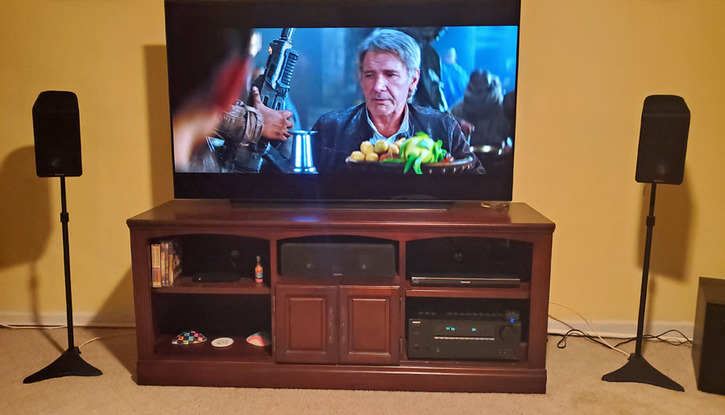
As a 5.1.4-channel passive speaker system, the Klipsch system does require a separate receiver or preamp/amp combo to power it. To take full advantage of all nine channels plus the sub, you should ideally have a nine channel receiver. This will normally be called a "9.1" or "9.2" channel receiver. But if you are rocking a 7.1 or 7.2-channel receiver (much more common in the budget price range), fear not! You can just opt to not connect the height channels on the rear speakers. This will give you a 5.1.2 channel system instead of 5.1.4, and it will simplify the wiring as well. But do make sure your receiver supports a Dolby Atmos system of at least 5.1.2 channels - five surround speakers, one powered subwoofer and two height channels.
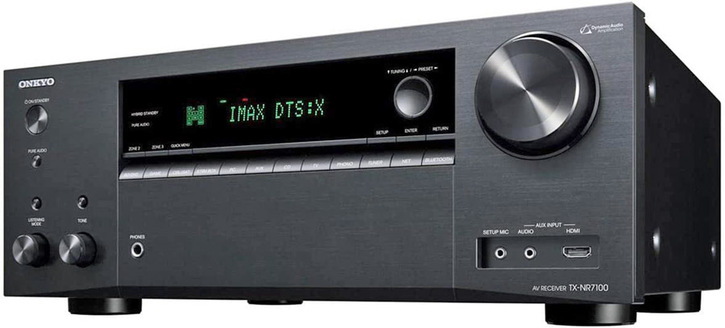
For a nine-channel (9.1) receiver, you'd need to budget at least $1600 for a current model like the excellent Denon AVR-X3800H. If you don't mind buying a slightly older model (introduced in 2021), you can find the Onkyo TX-NR7100 for under $900 or a Pioneer VSX-LX305 for under $1,000. If you opt for a 7-channel 5.1.2 configuration instead, we'd recommend the Denon AVR-S760H for under $500 or the Sony STR-AN1000 for under $800. All are capable of driving the Klipsch system to comfortably loud levels in a small to medium listening space. You can always start with a less expensive 5.1.2 (7 channel) receiver and upgrade to a more powerful 9 channel receiver when budget allows.
The four satellite speakers include the proprietary and distinctive-looking Klipsch 5 1/4-inch spun-copper driver paired with a 1-inch aluminum LTS tweeter using the company's Tractrix Horn for focused dispersion. For immersive surround (including Dolby Atmos), the top of each cabinet features a 4-inch polyfiber driver which bounces height effects off the ceiling, toward the listener. Each satellite speaker is about 13 1/2 inches high, 6 1/2 inches wide and 7 inches deep and weighs about 8 pounds. Satellites are rated at 92 dB sensitivity and have a rated frequency response of 90Hz-20KHz (+/-3dB).
The center channel includes two of the 4-inch copper spun drivers aligned horizontally flanking a 1-inch tweeter. The center channel measures in at 17 1/2 inches wide, 5 1/8 inches high and 6 inches deep and weighs about 7 1/2 pounds. The center channel speaker is rated at 91 dB with a rated frequency response of 90Hz-20KHz (+/- 3 dB).
The powered subwoofer measures in at 14 1/2 inches high, 12 1/2 inches wide, and 16 1/2 inches deep, and weighs about 24 pounds. The sub features an MDF cabinet and a 150 Watt Class D amplifier. It's a bass reflex design with a front-firing 10" high excursion spun-copper IMG (Injection-Molded Graphite) woofer and a rear-firing port. The subwoofer has a rated frequency response of 32Hz-120Hz (+/-3dB). The speaker grilles on the satellite speakers, center and subwoofer can be removed if you want to display those cool copper-colored drivers or left on, if you prefer.
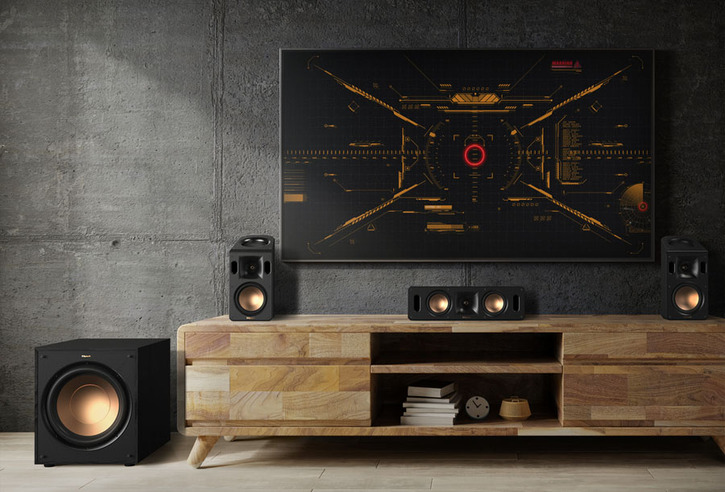
The system comes with several pre-cut spools of speaker wire, enough to wire all of the speakers. It's pretty basic stuff, very high gauge (very thin). It'll get you by in a reasonably small room, but if you have a larger room, you might want to invest in a spool of 16-gauge cable like this stuff from Monoprice. This 16-gauge pure copper Monoprice cable is CL3-rated for in-wall use and has 4 conductors which means you can use a single length of it to power both the main channel and the height channel for each satellite speaker.
All of the speakers in the system are wired (not wireless). This means you will need to run speaker wires to each speaker, but it also means you do not need to worry about plugging any of the speakers into wall power outlets. The only exception is the powered subwoofer. Like most subwoofers, the Klipsch sub does need to be plugged into wall power in order to pump out the bass jams. It also needs an RCA cable connected from your receiver's subwoofer output (a basic RCA cable is included in the box).
When wiring up the speakers, keep in mind that each of the four satellite speakers - left front, right front, left rear, right rear - has two speakers built in - one that directly faces the listening position, one that points up to the ceiling for height effects. This means you will need to run two sets of speaker wires from your receiver to each speaker (or one set of those Monoprice cables mentioned earlier). Make sure you keep the wire leads consistent. The Klipsch cables are red and black, plug the red side into the "+" (positive) terminal on the receiver and speaker and plug the black wire into the "-" (negative) terminal. The Monoprice cables are red, white, black, and green, so I used red and black for + and - on the main inputs and white and green for the + and - height channel inputs.
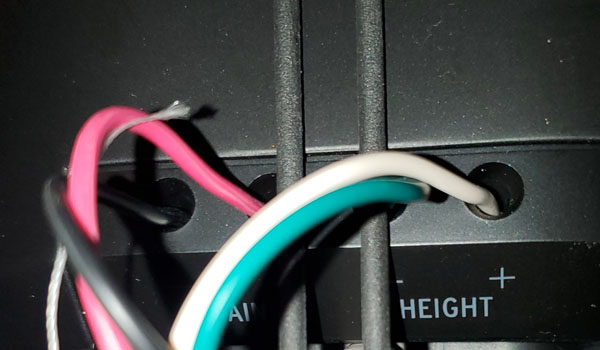
The Klipsch system's speaker terminals are of the basic spring-loaded variety. You can use bare wire (up to about 16 gauge) or pins, but not spades or banana plugs. The terminals are a bit wonky in that you have to push the wires in enough to make contact with the terminals, but not so far that the wire's insulation prevents contact. Look closesly to be sure the cables are inserted the right amount for a snug metal on metal contact.
In terms of speaker layout, the Klipsch user manual offers some helpful tips. Front speakers should be equidistant from the main listening position (typically the middle seat on the couch), center speaker should be just below or above the TV or projector screen, midway between the left and right front speakers. The rear channel speakers should be placed behind the listening position, pointing toward the listener, again equidistant from the primary listening position. The speakers have non-slip rubber bottoms that will keep them from slipping around too much on a speaker stand or console. You can use just about any sort of speaker stand to hold them, or even wall mount them using standard wall-mount brackets with a 1/4"-20 threaded mounting bolt.
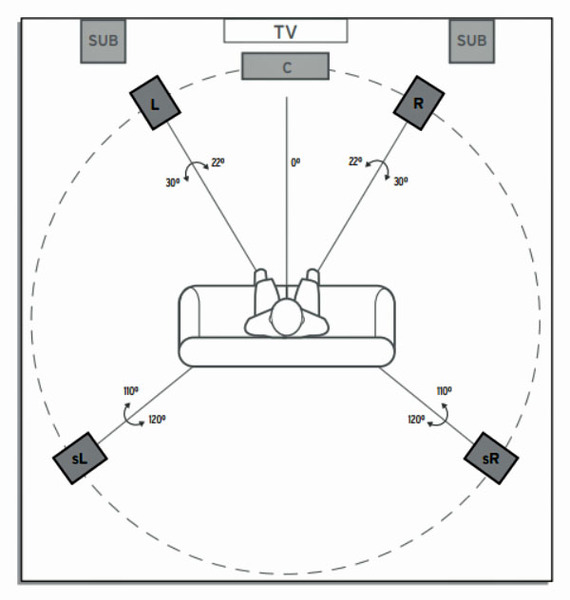
Once you have connected all of the available channel outputs into the speakers and placed them in their final positions around the room, connect the included RCA cable (or one of your own) from the receiver's subwoofer output to the subwoofer's input and plug the subwoofer into a power outlet. You may need to experiment a bit with subwoofer placement to get the best bass response and blend with the satellites. Generally speaking, when using a single subwoofer, you can get good sound with the sub placed somewhere along the front wall, not too close to a wall or corner so you can avoid some of the bass boom you get from border walls. Placing the sub very close to a wall or corner will lead to greater bass output, but possibly at the expense of its definition and clarity.
Once everything is connected, be sure to run your receiver's calibration program. On my test system, I used Onkyo's built in calibration routine to get all the levels in the right ballpark, but then made some manual level calibrations to tweak the final balance. I raised the center channel slightly for improved dialog intelligibility, raised the height channels by a couple of dB and also lowered the bass response slightly to prevent excessive bass output.
Having some experience with Klipsch systems in the past, including a few of their 5.1-channel "home theater in a box" systems and separate speakers, I was expecting a very punchy sound, possibly favoring the high frequencies. But with the Cinema Reference 5.1.4 system, I was surprised at by a slightly more laid back frequency blend. With horn-loaded tweeters, one might expect strident high frequencies but the actual sonic presentation was on the mellower side. The system was still punchy, detailed and dynamic, without being overly strident or brittle in any way. This blend worked well for both music and movies.
I had a music-loving friend drop by so I could play him some immersive Dolby Atmos music tracks from TIDAL. Not only was he blown away by the sound of the system (considering its entry-level price tag) but he immediately wanted to trade up from his Spotify account to a TIDAL HiFi subscription to get some of that sweet Dolby Atmos music (Spotify doesn't currently support immersive sound or spatial audio in any format).
Working through my standard repertoire of favorite Dolby Atmos music tracks on TIDAL, from A-Ha's "Take On Me" to INXS "Need You Tonight," from Queen "Bohemian Rhapsody" to multiple EDM tracks by deadmau5, Kaskade and KX5, the Klipsch system offered up full, expansive, room-filling sound with good midrange transparency, nice detail and solid, articulate bass. As mentioned, the overall mix was slightly on the warm side with excellent vocal presence on both male and female voices. The blend from left to right, front to back and top to bottom was fairly seamless.
Moving on to TV shows and movies, rain in the opening scene from the first episode of "Andor" permeated the room, falling lightly from the sky. Astronaut voices in the opening scene from "Gravity" closely tracked the position of the space-walking astronauts themselves, each voice coming from a unique point in space. Even non-Atmos soundtracks like Danny Boyle's "Yesterday" (in Dolby Digital+ 5.1 on VUDU) came through cleanly with clear dialog and singing, and finely detailed guitar strumming. But the system could do a huge room-filling surround soundscape as well when the lead character performs in Wembley (with Ed Sheeran as his opening act, of course).
What sets the Klipsch system apart from other entry-level 5.1.2 or 5.1.4 speaker systems (like the less expensive MonoPrice 5.1.2 system and more expensive NHT SuperZero 5.1.2 system) is that the satellite speakers are a bit larger, with more cabinet volume, allowing them to extend down to about 90-100 Hz. This extension allows them to reproduce even the lowest octaves of the human voice without having to hand off mid-bass frequencies to the subwoofer. This creates a more seamless experience when listening to music or dialog-heavy movies and TV shows.
Bass frequencies are well represented here, though don't expect the gut-wrenching bass you'd get from an expensive 12-inch powered sub. Bass definitely tapers off quickly below 40 Hz. But the bass that is here is firm and musical. Those who feel adventrous might try swapping in a more powerful subwoofer or even a second subwoofer for more uniform bass response throughout your room.
With a list price of almost $1,400 and previously exclusive distribution through Costco with a selling price around $900, we were surprised to see such a robust system selling for under $400. We spoke with a Klipsch rep at CEDIA Expo last month and he confirmed that the Klipsch Cinema Series 5.1.4 system is now on closeout. This means Klipsch lowered the wholesale price significantly and opened the product up to more retailers. So the discount price will only last as long as current stock. Once they're gone, they're gone for good.
Turn-ons:
Turn-Offs:
While Apple might try to make you believe that you can do immersive sound or "spatial audio" with just a pair of headphones, the fact is that immersive formats like Dolby Atmos, AURO-3D, 360 Reality Audio and DTS:X really sound best over speakers. And for those who want to experience that 3D immersive surround sound, the Klipsch Reference Cinema Series 5.1.4 System will get you there on a shoestring budget. Pay no attention to the "list price" of $1,349 as the actual street price should be closer to $400 for the full set.
Match them up with the Onkyo TX-NR7100 for under $900 for a full 5.1.4 channel immersive sound system or the Denon AVR-S760H for under $500 for a killer entry level 5.1.2 channel system. This system looks and sounds far too good for its price. Highly recommended.
Where to Buy:
Klipsch Reference Cinema Series 5.1.4 Speaker System on Amazon
| Overall | |
|---|---|
| Value | |
| Performance | |
| Features/Ergonomics |